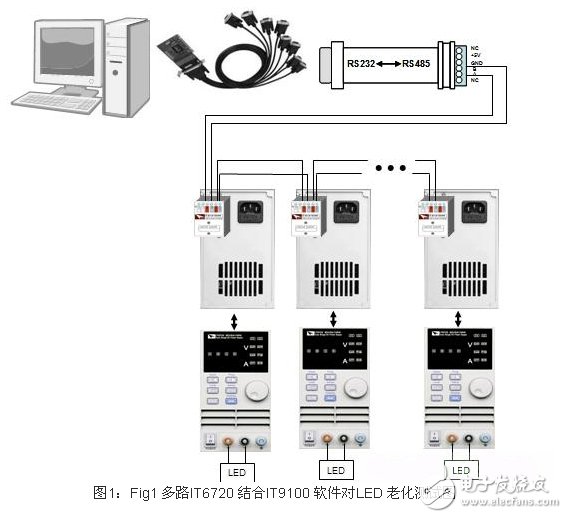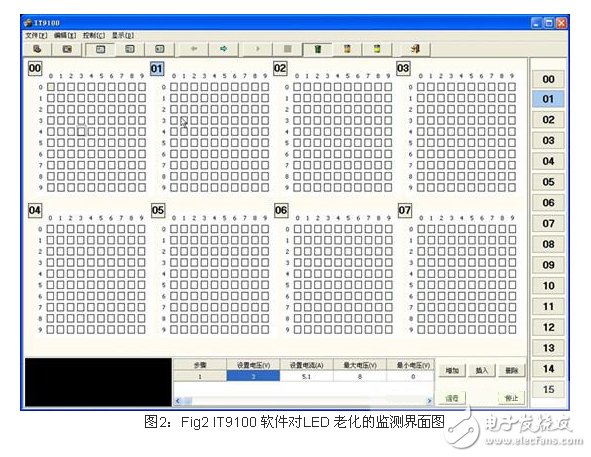This article introduces a long-term power-on aging test program for LED lighting products, which mainly explains how to combine the hardware products in the system and the main monitoring software to achieve the maximum effect of the power supply in the aging system and improve multiple The simultaneity and automation of the aging test of LED products obtains the most accurate monitoring data and the goal of maximizing labor cost savings. The system has been applied to actual aging tests and will be further promoted and applied in the LED industry.
The principle of LED lighting
The Chinese LED industry started in the 1970s. After more than 30 years of development, the Chinese LED industry has initially formed a relatively complete industrial chain including the production of LED epitaxial wafers, the preparation of LED chips, the packaging of LED chips, and the application of finished LED products.
LED lighting LEDs are made of III-IV group compounds such as GaAs (gallium arsenide), GaP (gallium phosphide), GaAsP (gallium arsenide) and other semiconductors, the core of which is the PN junction. Therefore, it has the IN characteristics of a general PN junction, that is, forward conduction, reverse cutoff, and breakdown characteristics. In addition, under certain conditions, it also has luminescent properties. Under forward voltage, electrons are injected into the P region from the N region, and holes are injected into the N region from the P region. A part of the minority carriers (minor carriers) that enters the opponent's area recombine with the majority carrier (multiple carriers) and emit light. Assuming that luminescence occurs in the P region, the injected electrons directly recombine with valence band holes to emit light, or they are first captured by the luminescent center and then recombine with holes to emit light. In addition to this luminescent recombination, some electrons are captured by the non-luminescent center (the center is located near the middle of the conduction band and the dielectric band), and then recombined with the hole. The energy released each time is not large and cannot form visible light.
Market requirements for LED lighting products
Some people call the LED light source a long-life lamp, meaning a lamp that never goes out. Solid cold light source, epoxy resin encapsulation, no loose parts in the lamp body, there are no shortcomings such as filament burning, thermal deposition, light decay, etc. The service life can reach 60,000 to 100,000 hours, which is 10 times longer than the traditional light source the above. Therefore, to achieve such an ideal state, anti-aging ability is particularly important.
1. Aging test of LED lighting products
The long-term aging test of LED backlight and lighting products is a very important test. Through the aging test, it is possible to find early failures such as light decay, color temperature change, and electrical leakage that may occur during long-term use of LED products. ITECH power supply and aging test software are mainly used for aging test of LED backlight and lighting products.
The results of the aging test of LED lighting products have a great relationship with the equipment used. The aging equipment and LED lighting products must ensure that the optimal aging time is determined under the condition of sufficient heat dissipation, and the aging system monitors data for analysis and comparison In order to get the most accurate test data, so as to achieve the purpose of production and testing.
Second, the characteristics of the power supply and aging system used in the LED aging test
Because the working current of LED is very special, it needs a professional test system to get reliable data. In general, the power supply and aging system used in the LED aging test should have the following characteristics:
1. The high power ratio CNC DC power supply has a wide voltage and current usage rate and a wide range of applications;
2. The rate of change of voltage and current can be automatically controlled to minimize the cost;
3. High precision and high resolution;
4. Low noise and ripple;
5. As small as possible, save space;
3. Construction of LED aging test system
The LED aging test system is built by DC power supply and control software, as shown in the following figure:

Note: The power supply model used in the above picture is ITECH IT6720, and the aging control software model is ITECH IT9100
The following figure is a screenshot of the interface observed by the user during the aging test using this test system:

In this interface, the aging of 16 * 32 channels of LED lighting or backlight products can be observed simultaneously. It is divided into 16 groups in total, and each group can have up to 32 channels, which are represented by arrays. Each block on the interface represents a channel. When the channel is configured, the channel block is gray. Using colors to distinguish between different operating states enables users to observe any subtle changes more clearly, easily, and quickly during use. Generally speaking, in order to conform to people's habits, the functions represented by different colors are as follows:
Gray: configured or stopped
Yellow: communication failed
Red: An error occurred during operation
Green: Communication and operation are normal
4. The advantages of choosing this LED aging test program
Choose flexible power supply, combined with multi-channel aging monitoring software, can realize aging monitoring test for hundreds of LEDs at the same time.
The advantages of this solution are:
1) The power supply is small and standard and can be placed on a standard instrument cabinet. The aging system can be easily designed and placed according to the actual situation. Avoid the complicated work of special custom aging test system cabinet;
2) The programmable power supply used is easy to operate, and has the characteristics of high accuracy and strong stability;
3) Intelligent fan control, low noise;
4) The aging value can be set in batches through software and the working status of each LED lighting product can be detected;
5) When the aging test bed continues to work for a long time, it is generally 72H, and there is no need to be on duty to wait;
6) Using monitoring software, data can be automatically recorded for easy analysis;
7) The price is reasonable, the construction is simple, and the future is highly scalable, which is very suitable for applications in this field.
V. Conclusion
The characteristics of LED luminescence put forward special requirements for the aging test scheme of LED lighting products. The LED aging test solution introduced above can be widely used in the aging test of LED lighting and backlight products, and the performance is perfect. Choose the power supply and control software professionally used in the LED industry, and build the above test system to get the most accurate and effective data.
PVC Insulated Cable (Wire)
1. Product standard
The product is manufactured according to the standard of GB5023-1997 and JB8734-1998 or IEC, BS, DIN and ICEA upon request.
2. Application
The product is suitable for use in power installations, fixed wiring or flexible connections for electrical appliances with rated voltages up to and including 450/750V respectively.
3. Operating characteristics
Rated voltages of Underground Cable U0/U: 450/750V.300/500V and 300/300V.
Max .Permissible continuous operating temperature of the conductor:
227 IEC 07 (BV-90) 90℃
227 IEC 08 (RV-90) 90℃
For other types 70℃
The ambient temperature under installation should not below 0℃
The bending radius of cable:
D≤25mm ≥4D
D>25mm ≥6D
(D-Diameter of the cable )
4. Type and Designation:
Type:
227 IEC 01(BV), 227 IEC 02(RV), 227 IEC 05(BV), 227 IEC 06(RV), 227 IEC 07(BV-90), 227 IEC 08(RV-90), 227 IEC 10(BVV), 227 IEC 42(RVB), 227 IEC 52(RVV), 227 IEC 53(RVV), 227 IEC 74(RVVYP), 227 IEC 75(RVVY), BV, BLV, BVR, BVV, BLVV, BVVB, BLVVB, RVS
Designation:
227 IEC 01(BV): Single-core non-sheathed cable with rigid conductor for general purposes
227 IEC 02(RV: Single-core non -sheathed cable with flexible conductor for general purposes
227 IEC 05(BV): Single-core non -sheathed cable with solid conductor for internal wiring for a conductor temperature of 70℃
227 IEC 06(RV): Single-core non -sheathed cable with flexible conductor for internal wiring for a conductor temperature of 70℃
227 IEC 07(BV-90): Single-core non -sheathed cable with solid conductor for internal wiring for a conductor temperature of 90℃
227 IEC 08(RV-90): Single-core non -sheathed cable with flexible conductor for internal wiring for a conductor temperature of 90℃
227 IEC 10(BVV): Light PVC sheathed cable
227 IEC 42(RVB): Flat non-sheathed flexible cord
227 IEC 52(RVV): Light PVC sheathed flexible cord
227 IEC 53(RVV): Ordinary PVC sheathed flexible cord
227 IEC 74(RVVYP): Oil-proof PVC sheathed, screened flexible cable
227 IEC 75(RVVY): Oil-proof PVC sheathed, non-screened flexible cable
BV: Copper conductor PVC insulated wire
BLV: Aluminum conductor PVC insulated wire
BVR: Copper conductor PVC insulated and sheathed round cable
BVV: Copper conductor PVC insulated and sheathed round cable
BLVV: Aluminum conductor PVC insulated and sheathed round cable
BVVB: Copper conductor PVC insulated and sheathed flat cable
BLVVB: Aluminum conductor PVC insulated and sheathed flat cable
RVS: Copper conductor PVC insulated twisted flexible cord for connection
![]()
PVC Single Core Cable,Building Flat Wire,Flat Building Wire,Electrical Cable Wires,Underground Cable
Huayuan Gaoke Cable Co.,Ltd. , https://www.bjhygkcable.com